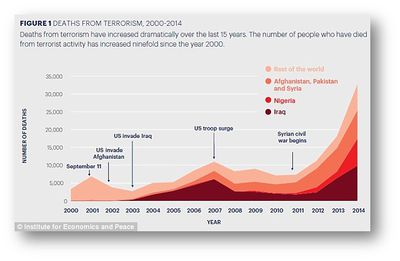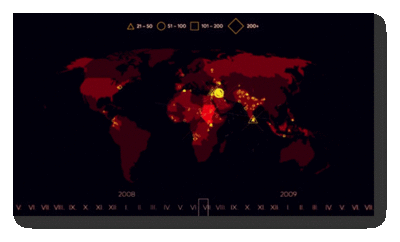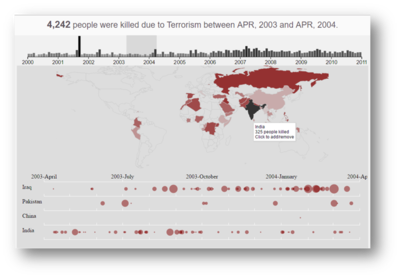Difference between revisions of "Staying Vigilant, Confronting Terrorism: Proposal"
Wx.tan.2013 (talk | contribs) |
Wx.tan.2013 (talk | contribs) |
||
| Line 39: | Line 39: | ||
{| class="wikitable" style="background-color:#FFFFFF;" width="100%" | {| class="wikitable" style="background-color:#FFFFFF;" width="100%" | ||
|- | |- | ||
| − | ! style="font-weight: bold;background: # | + | ! style="font-weight: bold;background: #536a87;color:#fbfcfd;width: 50%;" | Related Works |
| − | ! style="font-weight: bold;background: # | + | ! style="font-weight: bold;background: #536a87;color:#fbfcfd;" | What We Can Learn |
|- | |- | ||
| | | | ||
| − | <center>'''An Analysis of Death Tolls & Terrorist Incidents''' </center> | + | <p><center>'''An Analysis of Death Tolls & Terrorist Incidents''' </center></p> |
[[File:Related Works - Infographic Group7.jpg|400px|center]] | [[File:Related Works - Infographic Group7.jpg|400px|center]] | ||
| − | <center>'''Source''': http://www.dailymail.co.uk/news/article-3322308/Number-people-killed-terrorists-worldwide-soars-80-just-year.html</center> | + | <p><center>'''Source''': http://www.dailymail.co.uk/news/article-3322308/Number-people-killed-terrorists-worldwide-soars-80-just-year.html</center></p> |
|| | || | ||
* The infographic provides annotations to help the users understand major terrorist attacks that have happened overtime. | * The infographic provides annotations to help the users understand major terrorist attacks that have happened overtime. | ||
| Line 51: | Line 51: | ||
* Use of colors on the same color scale ensures that it will not confuse the users. Also, the need to reference to a legend repeatedly, to understand the data, will be reduced. | * Use of colors on the same color scale ensures that it will not confuse the users. Also, the need to reference to a legend repeatedly, to understand the data, will be reduced. | ||
|- | |- | ||
| − | | | + | | <p><center> '''An Animated Time-Lapse Visualization of Terror Attacks On The World Map''' </center></p> |
| + | [[File:Related Works - Time Lapse Group7.gif|400px|center]] | ||
| + | <p><center> '''Source''': https://www.youtube.com/watch?v=cHbYk2l9w-E </center> </p> | ||
| + | || | ||
| + | * The time-lapse animation provides a clear overview to users as it shows the spread of terrorist activities over the years. | ||
|- | |- | ||
| − | | | + | | <p><center> '''An Interactive Visualization to Show Trends And Events Shaping History of Terrorism''' </center></p> |
| − | + | [[File:Related Works - Interactive Visualization Group7.png|400px|center]] | |
| − | | | + | <p><center> '''Source''': http://parano.github.io/Global-Terrorism-Visualization/ </center></p> |
| + | || | ||
| + | * The time-series chart allow users to make use of a scrollbar to look at a time range (of 12 months). Use of a scrollbar act as a filter to look at the selected time range and this prevents users from getting overwhelmed by the data. | ||
| + | * The visualization consists of 2 charts linked together and this provides a clear representation of the spread of terrorist activities overtime. Firstly, the bar chart shows the number of fatalities in each month across the years. Secondly, the world map shows the spread of terrorist activities as user selects a time series. When the user drags across the scrollbar on the bar chart, the activities in the world map changes based on the selected time series. Such linkage between charts are useful and provides a good interactive tool to help users analyze spread of terrorist activities overtime. | ||
| + | * Use of tooltips allow users to know more information about the number of fatalities as they interact with the map. | ||
|} | |} | ||
| − | |||
| − | |||
| − | |||
| − | |||
| − | |||
<br/><div style="background: #364558; padding: 15px; font-weight: bold; line-height: 0.3em; text-indent: 15px;letter-spacing:-0.08em;font-size:20px"><font color=#fbfcfd face="Century Gothic">PROPOSED STORYBOARD</font></div> | <br/><div style="background: #364558; padding: 15px; font-weight: bold; line-height: 0.3em; text-indent: 15px;letter-spacing:-0.08em;font-size:20px"><font color=#fbfcfd face="Century Gothic">PROPOSED STORYBOARD</font></div> | ||
Revision as of 11:46, 4 October 2016
The threat of terrorism is growing everyday and many countries, including Singapore, have taken steps to mitigate the risks of terrorism. In the National Day Rally 2016, PM Mr. Lee Hsien Loong mentioned that diplomats and security forces have been doing their job well but despite their efforts, it does not mean that terrorist attacks will not happen in Singapore. The recent attack that attempted to fire a rocket to hit Marina Bay Sands Area from Batam was successfully intervened but this signals to the country that the terrorism threat should not be taken lightly. In response to the growing terrorist threat, the SGSecure Movement was launched to prepare the public in the event of an attack. In recent years, there is a rise in research on terrorist organizations and the activities they have performed, regardless of scale, over the years. However, more still needs to be done to analyze past terrorist activities and gain insights from it easily so that all countries could better prepare for a worst case scenario.
In this project, we are interested to find out and understand the spread of terrorist activities and the behavior of terrorists’ organizations and their attack patterns (e.g. bombing, assassination, shooting) regionally/globally. This allows respective policy makers, government or intelligence agencies to better analyze terrorist organizations and their spread internationally so that they could devise appropriate policies/measures to prevent potential attacks in future.
The final visualization aims to help analysts perform the following:
- Understand the spread of terrorist attacks and its fatalities regionally/globally
- Understand the spread of terrorist organizations and their attack activities regionally/globally
The dataset for analysis will be retrieved from the Global Terrorism Database (https://www.start.umd.edu/gtd/using-gtd/).
Our project will analyze on the following attributes:
- Geographical spread of terrorist attacks
- Type of terrorist attacks (e.g. bombing, assassination, bombing etc.)
- Target of terrorist attacks (e.g. police, embassy etc.)
- Perpetrators of terrorist attacks (e.g. ISIS, Al-Qaeda etc.)
- Weapons used in terrorist attacks (e.g. chemical, fireams etc.)
- Extent of damage in terrorist attacks
Many visual and data analysts have made use of data collected from the Global Terrorism Database to visualize and understand the extent of terrorist attacks around the world. Some of their works include the following:
| Related Works | What We Can Learn |
|---|---|
|
|
|
| |
|
Our group has proposed the following storyboard to assist analysts in the use of our visual application:
Our group attempts to perform self-learning on the respective visualization tools and technologies that we may apply throughout the course of this project. Peer learning will take place during meetings for us to learn from each other and apply these techniques to our project. During the process of data cleaning, preparation and analysis, our group aims to conduct these activities together. After we have performed a detailed analysis, we will then derive the respective deliverable that will be included in the final visualization application. Tasks (e.g. visual design, animation, application development, etc.) will be delegated to each group member for the project completion.
The following shows our project timeline for the completion of this project:
Feel free to comment to help us improve our project! (:



